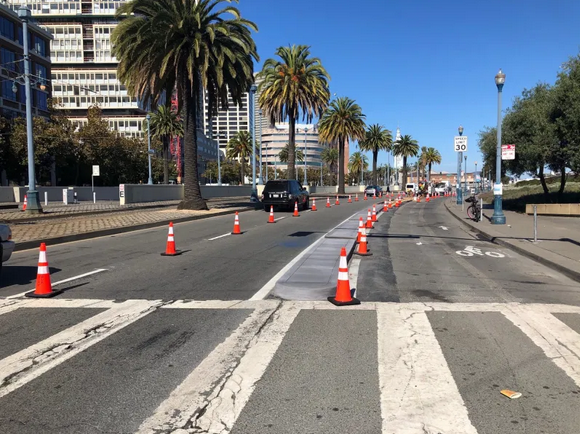Note: GJEL Accident Attorneys regularly sponsors coverage on Streetsblog San Francisco and Streetsblog California. Unless noted in the story, GJEL Accident Attorneys is not consulted for the content or editorial direction of the sponsored content.
A concrete curb was added late last week to a section of protected bike lane now under construction on the Embarcadero. This new bike infrastructure will give bike-ferry commuters a safe connection to the protected bike lanes on Howard and Folsom, and a safe route into SoMa. Work is also going on to fix a particularly troublesome spot a mile north in front of Pier 35.
"The new protected lane is incredibly appreciated work from SFMTA staff. The Embarcadero is the front line of sea level rise and climate change in San Francisco," wrote People Protected Bike Lane's Matt Brezina, who led many actions over the years to push for protected bike lanes on the Embarcadero. "We need more people to choose light electric mobility (ebikes, scooters, family bikes) to reverse climate change, and families will only make this choice when it is safe to do so."
As seen in the tweet by advocate Jef Poskanzer, the project is also aimed at preventing valets from the Waterbar restaurant from using the bike lane as a drop-off zone. In pre-COVID times, this was a source of conflict as cyclists were continually endangered by the restaurant's reckless operations.
Work is progressing steadily. "There is about 6-8 weeks of work left for Harrison - Mission. The final touches will be bike signals at Howard and some 2-way bikeway striping," wrote SFMTA's Benjamin Barnett in an email to Streetsblog.
Streetsblog first reported on this improvements at the start of September, when safe hit posts and paint first appeared. The concrete curbs are a welcome addition as progress continues.
Embarcadero protected two-way bike lane is going in! pic.twitter.com/GQFP3VTmR8
— Samuel Maskell (@samuelmaskell) October 8, 2020
Meanwhile, another Embarcadero improvement is underway at "Bay - North Point," added Barnett, adding that it "will be done in the next 2-3 weeks."
Barnett is referring to work intended to solve the treacherous situation that existed in front of Pier 35. Previously, the northbound bike lane forced cyclists (and pedicab operators) to navigate an obstacle course of delivery trucks and double-parked cars unloading at the pier. The SFMTA photo below from the agency's project page illustrates why this was so dangerous:
Advocate and Embarcadero commuter Bruce Halperin emailed Streetsblog photos of the work over the weekend in front of Pier 35 in District 3. The bike lane is now re-routed along the curb with parking spaces to the left of the bike lane, in the standard parking-protected configuration.
Here's what the same spot looked like previously, inviting double parking and drop offs on the bike lane:
From the SFMTA page on both projects:
Conditions along the Embarcadero Promenade have also deteriorated with daily ‘near misses’ and complaints of conflict between pedestrians and various wheeled/electric devices. There is a growing desire to regulate the use of devices such as electric standing scooters and electric bicycles along the promenade. Furthermore, emerging mobility service and technology types such as ride-hailing and motorized micro-mobility devices - to say nothing of the COVID-19 pandemic - are changing the way people use and share space on the road, at the curb, and on the promenade. These pressures are on top of the Embarcadero's vital contribution to providing maritime and industrial access while serving the curbside loading and delivery needs of Port businesses.
Obviously, much work remains to be done before anyone can call the Embarcadero safe for users of all ages and abilities. Even when these two small projects are done, the overwhelming majority of the street will remain dangerous for vulnerable road users. However, "This shows what's possible for all of the Embarcadero. These new concrete separators will save lives and help more people feel safe riding their bike along our waterfront," said Danny Sauter, President of North Beach Neighbors, currently running for District 3 Supervisor (Sauter is endorsed by the San Francisco Bicycle Coalition). "Especially at a time like this when most of the transit lines along the Embarcadero are out of service, we need to be making more space for travel by bike."
"These quick-builds were announced just before the pandemic hit and we're thrilled to see them finally go in the ground," wrote the SFBC's Janice Li, in an email to Streetsblog. "The work isn't done though, and since the project launched in 2014, we have consistently supported and continue to call on the City to deliver fully protected bike lanes along the entirety of the Embarcadero. Our world-class waterfront deserves world-class biking infrastructure."
"SFMTA should make the entire bay-side of the Embarcadero car-free from the ferry building to pier 39. This could be San Francisco's grand new linear park. A tourist attraction in itself. Imagine more trees, public art, play spaces for children, safe pedicab rides, food trucks, and civic pride on our water front instead of a highway," said Brezina. "This three-block stretch of protected bike lane is just the beginning."






